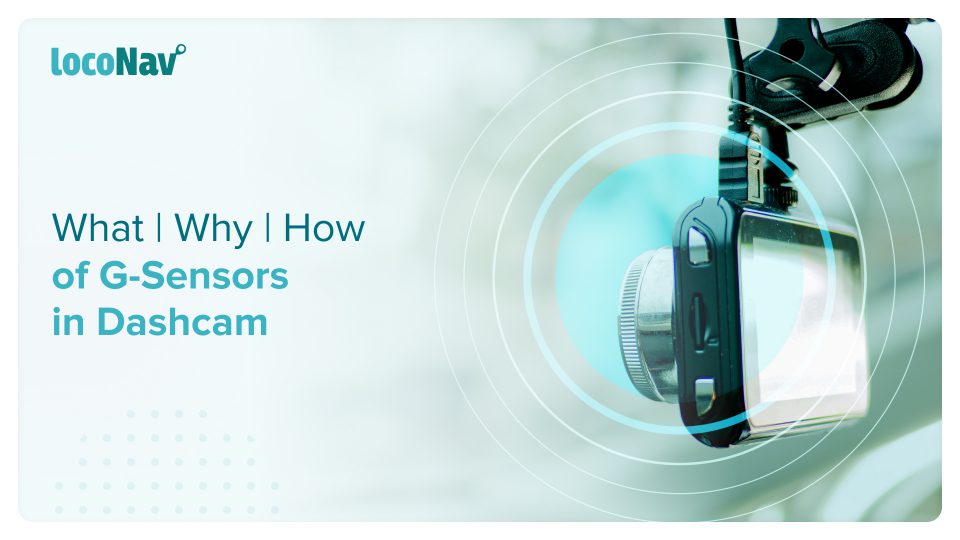

Faster speeds can now be achieved as vehicles have improved with technical developments, and unpleasant minor bumps, as well as more major accidents, were a consequence of human use. Automobile makers grew more concerned with enhancing vehicle safety and reducing injuries and fatalities. It is impossible to overestimate how much car safety has gotten better. But, as previously said, accidents can and do occur. We have gone from mere seat belts and airbags to technological advancements such as G Sensors.
This blog is to deep dive into one such aspect of vehicle safety, which is G sensors. So, let’s discuss what a G Sensor is, why is it used, its association with a dashcam, and its future scope.
What is a Gravity Sensor or G sensor?
G sensor, gravity sensor, or accelerometer on a dashcam is used to measure accurate acceleration, also known as G-Force. In other words, an abrupt change in direction will be detected by the dash camera.
This could be triggered by forceful braking, a collision, or even movement while stationary, such as someone shaking the vehicle. When a dash camera senses this change of direction, it enters ‘event mode’ and saves the present section of footage in a secure region of memory. This varies by brand, but dash cams often save footage from 10 seconds before an event to a minute following. This guarantees that the point of impact is remembered for later retrieval. The time frame and sensitivity of the G sensor can be altered to suit your needs.
What is the purpose of the G Sensor in a Dashcam?
A G sensor system refers to the dash camera’s gravity sensing function. The system may record the gravity sensing data and make a decision based on the ambient up and down, left and right, and front and back offset.
Gravity sensing is used to connect the dashcam to the car for the driving recorder. When the car vibrates due to a collision when the dashcam is in normal operation, the car recorder will instinctively lock the video footage to ensure that it is not destroyed in future recordings and that the video evidence is maintained.
How does a Dashcam with built-in G Sensor work?
When an impact is detected by the built-in g-sensor, the digital rearview mirror will immediately lock the current file and store it in a standalone file for you to examine and download later. Based on the driving conditions, the responsiveness level can be set to “High,” “Medium,” or “Low” in the settings.
For example, if you decide to go off-roading, you might want to set the sensitivity to low to avoid freezing too many files. You can see the incident footage directly on the digital screen via video playback, or you can take out the SD card and upload the file to your laptop or desktop.
What types of Moments are Detected with a G Sensor?
One of the most important features of a dash cam is impact and motion detection, which is often present exclusively in expensive models.
- Impact detection refers to recording a video file when activated by an internal, built-in G-sensor, whereas
- Motion detection refers to recording a video file when triggered by movement observed by the video sensor.
These two characteristics ensure that your vehicle is always safeguarded, such as when a person or vehicle passes by and, more crucially, when your vehicle is damaged.
What is the future of Dashcam-equipped G Sensors?
To make sensor data meaningful, fleet operators are increasingly expecting the capacity to analyze it in real-time on the cloud, rather than having to queue for vehicles to return to base to collect critical information.
Older and lower-quality dash cams depend on GPRS data transfer, which provides low-bandwidth transfer speeds unsuitable for Full HD video recording and massive amounts of sensor data.
As a result, the latest generation of dashcams has quicker and more capable 4G LTE compatibility, allowing the firmware to be upgraded over the air (OTA) and real-time telemetry data relay.
FAQ
What is Gravity sensor sensitivity?
Since the dashcam is always filming while driving, if anything activates the G-sensor, the film will be locked for 5 secs before and 15 secs after the incident. This is the G-Sensors’ sensitivity. When it comes to G-sensor sensitivity, the more sensitive it is, the more footage is stored.
What are the common triggers of G sensor sensitivity?
The common triggers of G-Sensor sensitivity are vehicle collision, impact detection, or motion detection around the vehicle.
How to know if a G sensor is working or not?
G-Sensor Test: examines the device’s G-Sensor, which is utilized for automated screen rotation. Set the gadget down on a flat surface. If the G-Sensor is functioning properly, the lettering will change green, indicating a PASS.
Is it possible to recover G-Sensor footage?
Yes, G Sensor footage is recorded onto the dashcam’s memory card and can be retrieved from there.
How do I activate the G Sensor function on Dashcam?
To enable the G-sensor capability on your dashcam, simply navigate to the device’s settings. As soon as your onboard camera senses a motion or a change in speed or direction, the recording will begin immediately.
How to calibrate a G sensor?
When using a dashcam equipped with a G-Sensor, you may discover that it picks up false negatives. Going over a pothole or shutting the door could both be considered “events.” You can re-calibrate it if these become too bothersome.
Navigate to the settings of your dash cam. It should have a setting for it. There will normally be four options: low, medium, high, and off. The default setting is medium, but if you find it too sensitive, reduce it to low.
What is G sensor parking mode?
G sensor parking mode detects impacts when the vehicle and dashcam are in parking mode.